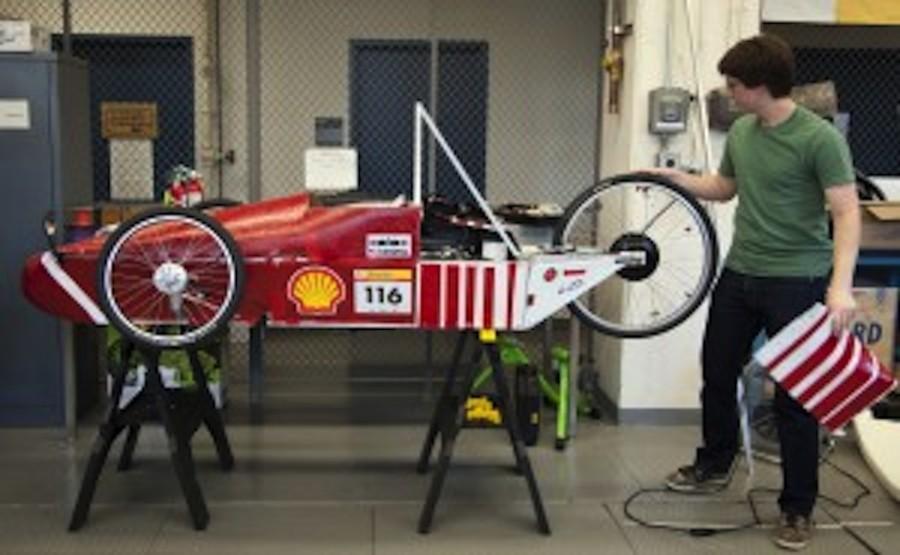College team in a race to save gas
Swarthmore engineering student Neil McFarland works on hydrogen powered car, April 16, 2014, in Swarthmore, Pa., that he will enter in the Shell Eco-marathon.
May 1, 2014
By Tom Avril
PHILADELPHIA — Its top speed is 35 m.p.h. It has less horsepower than a lawn mower.
Nevertheless, the bright-red, fiberglass-paneled contraption in a Swarthmore College basement is very much a race car — in a race to use as little energy as possible.
The svelte, three-wheeled vehicle is headed to Houston this week to compete among 125 entrants in the Shell Eco-marathon Americas.
Proud of your hybrid’s gas-sipping economy? Take a backseat. Some of the cars in the running can achieve thousands — yes, thousands — of miles per gallon of gasoline. In the 2013 contest, Laval University in Quebec took top honors with 3,587 miles per gallon.
Swarthmore’s machine is somewhat less frugal, at the equivalent of less than 1,300 miles per gallon, though a direct comparison with gasoline engines is tricky since it is powered by a hydrogen fuel cell.
And don’t get the idea that these curiosities will be showing up on the Schuylkill Expressway. The Swarthmore car weighs just 137 pounds and is 8 1/2 feet long.
“It’s a demonstration,” said engineering professor Nelson Macken, the project’s faculty adviser. “Totally unrealistic.”
Still, the race offers an idea of what might be possible on roadways of the future, with sleek, efficient vehicles powered by a variety of fuels. As in the competition, the cars of tomorrow are likely to come in several flavors, depending on where you live in the country and which energy sources are most readily available.
The Eco-marathon field is divided into two main categories. “Urban concept” vehicles are required to look somewhat like contemporary passenger cars, with four wheels and a roof over the driver’s head. Creators of prototype vehicles, such as Swarthmore’s, have freer rein.
Entrants must complete 10 laps of a 0.6-mile course laid out on the streets of Houston, for a total of six miles. Shell first held the “Americas” edition of the race in 2007; a sister event in Europe dates to 1985.
Swarthmore graduate Eric Verhasselt started building the school’s car in 2012, welding the aluminum chassis in the summer before his senior year.
The biggest expense was the $10,000 fuel cell, which the college already owned, having purchased it for previous projects. Additional money came from the Halpern Family Foundation Engineering Design Fund, plus the college and Shell.
Verhasselt took the car to Houston last year for its first Shell competition, placing third of six hydrogen-powered vehicles.
Junior Neil Macfarland is continuing the effort this year. He helped Verhasselt with the initial design, and now is tweaking and testing the car to maximize its efficiency. (Turns out it runs best at just 15 m.p.h.)
Also helping are junior Andrew Grasberger and freshman Persis Ratouis, among others.
Don’t forget secret weapon Winnie Ngo, a junior from Oakland, Calif., who will be behind the wheel.
The computer science major weighs just 95 pounds and stands 4 feet, 10 1/2 inches, allowing her to fit into the small car with room to spare. The rules require the driver to weigh at least 110 pounds, so Macfarland will have to add some ballast to the vehicle to compensate.
Much better than having the 6-foot-1 Macfarland drive. Since his long limbs do not fit inside the cockpit, he had to remove the car’s body panels to take it for a brief spin on campus.
“People were turning and staring,” Ngo said.
The hydrogen for Swarthmore’s car is stored in a cylindrical tank behind the driver’s seat. It generates electricity in the fuel cell, a black box mounted nearby.
The principle of a fuel cell is the reverse of that stock experiment in high school chemistry class, of zapping water with electricity to separate it into hydrogen and oxygen. A fuel cell combines hydrogen and oxygen, yielding water and electricity.
Fuel cell cars have zero tailpipe emissions, though their true level of greenness depends on the type of energy used to produce the hydrogen.
One day last week, Macfarland had a more pressing concern: The car would not start.
“Right now, we’re chasing electric gremlins around the car,” Macfarland said.
The culprit turned out to be an emergency shutoff switch that had jammed, and Macfarland had it working again in short order.
The three-day competition opened on Friday.
Start your engines! Or fuel cells.
©2014 The Philadelphia Inquirer
Visit The Philadelphia Inquirer at www.philly.com
Distributed by MCT Information Services








